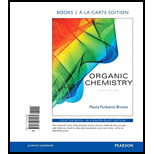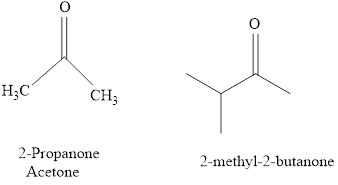
a.
Interpretation:
Name the given compound.
Concept introduction:
The nomenclature of
Naming Aldehydes:
Aldehydes have at least one hydrogen attached to the carbonyl carbon atom.
The IUPAC naming of an aldehydes is obtained by replacing the final "e" on the name of the parent hydrocarbon with "al".
The common name of the aldehyde is substituted for "oic acid" at the end of parent hydrocarbon chain.
For example:

Naming Ketones:
Carbonyl carbon atom attached to the two oxygen atoms.
The IUPAC name of a ketones are obtained by replacing the "e" on the end of the parent hydrocarbon with "one".
Only few ketones have common name.
For example:

b.
Interpretation:
Name the given compound.
Concept introduction:
Naming Aldehydes:
Aldehydes have at least one hydrogen attached to the carbonyl carbon atom.
The IUPAC naming of an aldehydes is obtained by replacing the final "e" on the name of the parent hydrocarbon with "al".
The common name of the aldehyde is substituted for "oic acid" at the end of parent hydrocarbon chain.
For example:

Naming Ketones:
Carbonyl carbon atom attached to the two oxygen atoms.
The IUPAC name of a ketones are obtained by replacing the "e" on the end of the parent hydrocarbon with "one".
Only few ketones have common name.
For example:

c.
Interpretation:
Name the given compound.
Concept introduction:
Naming Aldehydes:
Aldehydes have at least one hydrogen attached to the carbonyl carbon atom.
The IUPAC naming of an aldehydes is obtained by replacing the final "e" on the name of the parent hydrocarbon with "al".
The common name of the aldehyde is substituted for "oic acid" at the end of parent hydrocarbon chain.
For example:

Naming Ketones:
Carbonyl carbon atom attached to the two oxygen atoms.
The IUPAC name of a ketones are obtained by replacing the "e" on the end of the parent hydrocarbon with "one".
Only few ketones have common name.
For example:

d.
Interpretation:
Name the given compound.
Concept introduction:
Naming Aldehydes:
Aldehydes have at least one hydrogen attached to the carbonyl carbon atom.
The IUPAC naming of an aldehydes is obtained by replacing the final "e" on the name of the parent hydrocarbon with "al".
The common name of the aldehyde is substituted for "oic acid" at the end of parent hydrocarbon chain.
For example:

Naming Ketones:
Carbonyl carbon atom attached to the two oxygen atoms.
The IUPAC name of a ketones are obtained by replacing the "e" on the end of the parent hydrocarbon with "one".
Only few ketones have common name.
For example:

Want to see the full answer?
Check out a sample textbook solution
Chapter 16 Solutions
Organic Chemistry, Books a la Carte Edition (8th Edition)
 Organic Chemistry: A Guided InquiryChemistryISBN:9780618974122Author:Andrei StraumanisPublisher:Cengage Learning
Organic Chemistry: A Guided InquiryChemistryISBN:9780618974122Author:Andrei StraumanisPublisher:Cengage Learning EBK A SMALL SCALE APPROACH TO ORGANIC LChemistryISBN:9781305446021Author:LampmanPublisher:CENGAGE LEARNING - CONSIGNMENT
EBK A SMALL SCALE APPROACH TO ORGANIC LChemistryISBN:9781305446021Author:LampmanPublisher:CENGAGE LEARNING - CONSIGNMENT


